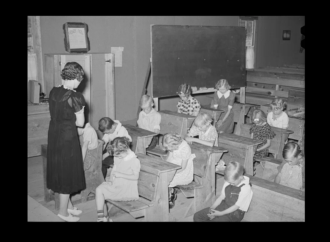Millennials approach religion differently than their forebears. They are more likely to be “nones,” less likely to frequent religious institutions or adhere to a particular faith.
Some have wondered whether Millennials’ views on religion might change with age, as many of them have taken longer to hit other life milestones, such as getting married, having children, and buying a home. It would make sense if they decided to join churches, synagogues, or mosques only later on.
But now it’s looking like time, by itself, will not change Millennials’ religious inclinations. FiveThirtyEight has the story:
[M]any millennials have spouses, children and mortgages — and there’s little evidence of a corresponding surge in religious interest. …For one thing, many millennials never had strong ties to religion to begin with, which means they were less likely to develop habits or associations that make it easier to return to a religious community. …Changing views about the relationship between morality and religion also appear to have convinced many young parents that religious institutions are simply irrelevant or unnecessary for their children.
For secular observers, this should raise a few questions. For one thing, actively religious people tend to be happier and more active in their communities. The more important religion is to a person, the more likely he is to give money to charity. And according to a 2015 review of literature on the topic, religious involvement is “related to better coping with stress and less depression, suicide, anxiety, and substance abuse.” As religious faith declines in the U.S., we need to consider the impact this will have on the civic and emotional wellbeing of Americans who identify as “nones.”
Although material wellbeing in our country is quite high, mental health struggles and suicide rates are worsening every year. And while there are a variety of potential reasons for this (overwork, stagnant wages, social isolation, and cyberbullying among them), a lack of religious adherence could be exacerbating the problem, as well as impeding efforts aimed at prevention and treatment.
Are there church replacements people might seek out for emotional and communal support? There’s some indication that organizations such as CrossFit and SoulCycle or Alcoholics Anonymous could be filling the need for ritual, community, accountability, and meaning. As I wrote for TAC last year, many secular institutions offer adherents teleological narratives and opportunities for vulnerability and connection – even as many of our churches have gotten larger, less ritualized, and more consumptive.
There’s also some indication that consumerism serves as its own religion. In his book The Enchantments of Mammon, Eugene McCarraher suggests that capitalism has replaced Christian beliefs by “offer[ing] the sale of commodities, not the dutiful worship of relics; the fulfillment of the self, not the subordination of the past; the romance of the present and the promise of the future, not a vale of tears and a hope beyond the grave.” McCarraher sees “the Nike swoosh, the Starbucks siren, and other trademarks” as “totems of enchantment,” symbols of desire, reverence, and community. James K.A. Smith describes the shopping mall in his book You Are What You Love with similar language:
The layout of this temple has architectural echoes that hark back to the medieval cathedrals—mammoth religious spaces that can absorb all kinds of different religious activities all at one time. And so one might say that this religious building has a winding labyrinth for contemplations, alongside of which are innumerable chapels devoted to various saints. As we wander we’ll be struck by the rich iconography that lines the walls and interior spaces. Here is an array of three-dimensional icons adorned in garb that inspires us to be imitators of these exemplars. These statues and icons embody for us concrete images of “the good life.” Here is a religious proclamation that does not traffic in abstracted ideals or rules or doctrines, but rather offers to the imagination pictures and statues and moving images, offering embodied pictures of the “redeemed” that invite us imagine ourselves in their shoes.
Considering all this, it appears we are not actually growing less religious. We’re just investing our religious energies in different places, different “faiths.”
But there is something inherently classist and exclusive about the new religions we’ve built for ourselves. It takes money to invest in the religion of capitalism, to participate in the shopping mall cathedral – or even to join a CrossFit or SoulCycle group. The only “religious” group listed above that does not come with a price tag is Alcoholics Anonymous – but it’s also importantly, inherently exclusive. It provides an intimate space for people with a specific struggle, and is not meant to be universal.
Religious faiths, in contrast, are free and universal. They offer an ethical and philosophical backbone that’s lacking in capitalist creeds and the CrossFit canon. In his book Dignity, Chris Arnade considers the role that churches played in every struggling community he visited: “Often the only places open, welcoming, and busy in back row neighborhoods were churches or McDonald’s.” Over the course of writing his book, Arnade found “dirty Bibles in crack houses, Korans in abandoned buildings. There is a picture of the Last Supper that moves with a couple living on the streets. It is the only real possession they own, beyond the Bible. …Rosaries, crucifixes, and religious icons are worn for protection and good luck.”
Churches offer all the ability to, as Arnade puts it, “‘Enter as you are,’ letting forgiveness wash away a past that many want gone. …The churches understand the streets, understand everyone is a sinner and everyone fails.” Here, the accountability and community people need are still available – and the principles necessary to our search for purpose and hope remain intact.
I used to think we were living in a disenchanted world – that Americans had dispensed with mysticism and wonder as scientific determinism increased. But even as religious “nones” have grown in Europe and America, belief in spirits, witches, psychical powers, magic, astrology, and demons has persisted. I think the working class and the poor are often more likely to see the world as animated by good and evil forces. The people Arnade talks to in his book have a deep, visceral understanding of evil and its power – and they turn to their church or religious group to find solace and strength as they confront that evil. Certain other sectors of society – the middle class and elites, for instance – seem to have switched their allegiance from spiritual mysticism to the aforementioned materialistic religions. But either way, our world is still enchanted. People still seek out meaning. The question is where – and whether – they can find it.
Religious readers may experience frustration or fear as they consider young Americans’ indifference toward organized religion. Church leaders may wonder how best to reach young people who no longer see religious belief as necessary or beneficial. I have considered how to do this in years’ past, and hope at least a few of these thoughts might be relevant today.
But those of us who are religious must consider, too, whether our actions and words distance our coworkers and neighbors from our beliefs – or whether they present an appealing vision of the life of faith. I have long wondered whether ties between religious faith and politics here in America are counterproductive in drawing people to the church. If a Millennial hears the word “Christian” and immediately thinks “Trump,” there is little we can do to convince him that religious faith is bigger than any political box or partisan belief. If our neighbors see church as exclusively “for” a particular political party, income, class, or race, then of course they will distance themselves from it.
We humans will always search for meaning and community. We need to belong somewhere, to have purpose. It could be that younger Americans will seek and find these things outside organized religion. But there’s also a chance that, with time, secular “religions” will eventually let them down. As our bodies deteriorate, gyms and shopping malls can only do so much. Which is why, so often, humans turn to the eternal and the spiritual for hope and meaning. As the Psalmist puts it, “My flesh and my heart may fail, but God is the strength of my heart and my portion forever.”
And so I think there is hope for Arnade’s churches: places that offer hope and hospitality in a dark, broken world. When everything else fails, we still need a place where we can be forgiven – perhaps even made new.
—
This article has been republished with permission from The American Conservative.
Dear Readers,
Big Tech is suppressing our reach, refusing to let us advertise and squelching our ability to serve up a steady diet of truth and ideas. Help us fight back by becoming a member for just $5 a month and then join the discussion on Parler @CharlemagneInstitute!
[Image Credit: Pixabay]
















Leave a Comment
Your email address will not be published. Required fields are marked with *